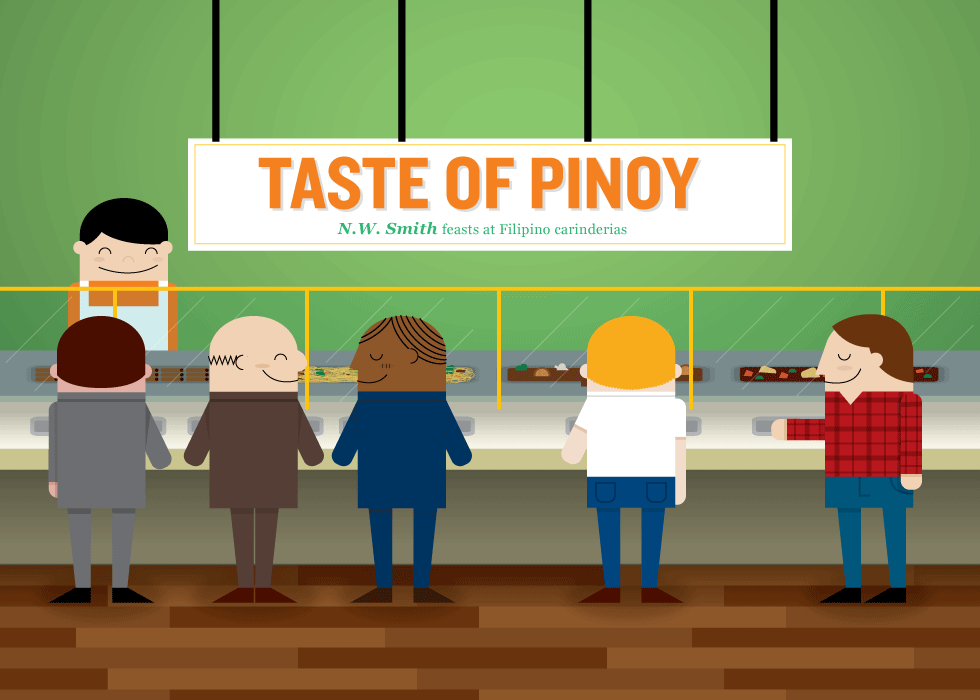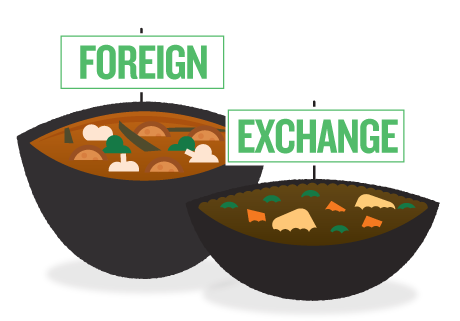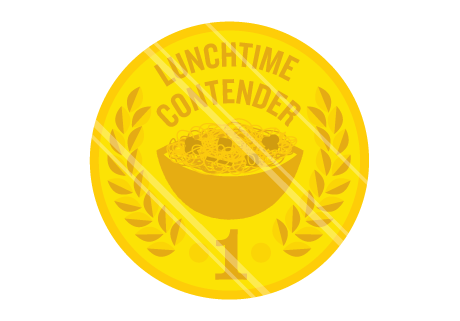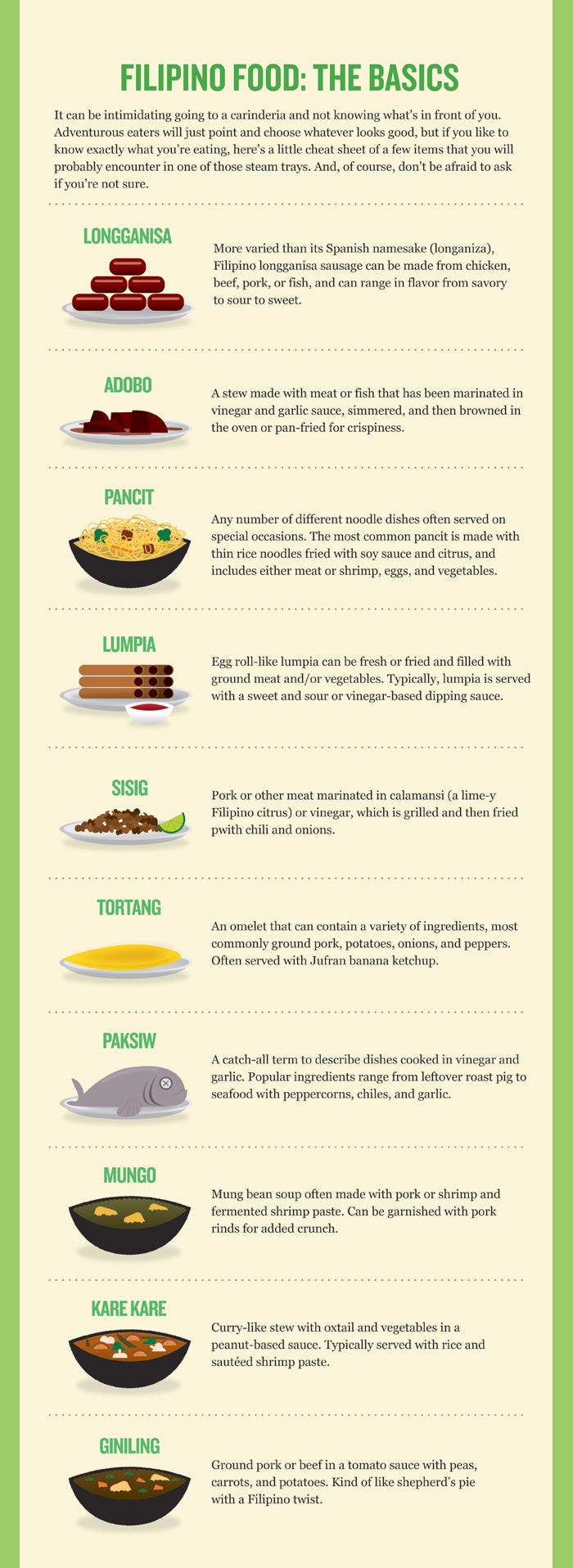By N.W. Smith

You may think of the Bay Area as one of the epicenters of fusion cuisine,
but people in the Philippines have been combining elements of Asian, Pacific, and Western ingredients and techniques long before Alice Waters and food cart vendors were concocting combinations of cuisines from around the world. The Filipino national cuisine is as unique and diverse as the country itself.

The extent of my exposure to Filipino food has been pretty much limited to what I’ve seen on TV, and I am a bit intimidated. After watching Bizarre Foods’ Andrew Zimmern, sweaty and bug-eyed, lurching through the streets of Manila in search of balut (fertilized duck eggs), I realize I need some help navigating the vast world of Filipino cuisine. As a clueless “kano” (white boy), I decide to bring along a Filipina friend of mine, Pauline, to help me out on my first stop.
Pauline and I head downtown to Kusina Ni Tess, a small mom and pop joint hiding in the shadows of the Hilton. The inside is cozy, with tables lined up along the wall opposite the cafeteria-style counter. The smell of stewed meats and slow-cooked sauces piques my appetite.
Pauline is as excited as I am because she’s passionate about Filipino food. “It’s a hidden treasure,” she says beaming, “Our food is inspired by all of the people that came into our country: Chinese, Japanese, Spanish, American — its like a big buffet of everything!” As we sidle up to the counter and gaze at the variety of dishes, the influences become apparent. “Pancit, lumpia — we got that from China,” Pauline explains. The guy behind the counter offers me a sample of a dish made from ground beef with peas, carrots, and potatoes. “Giniling, or picadillo,”he explains. The Spanish roots are clear, given the name and ingredients, but the salty tang of soy sauce belie its Asian influences. After sampling the paksiw, fish stewed in a delicious vinegar, fish sauce, and ginger broth, we settle on the kare-kare, mungo, and some lumpia. According to Pauline, “kare” is the Japanese word for curry. This dish features fall-off-the bone tender oxtail simmered in a rich peanut curry sauce. “A little sweeter than how my dad makes it, but still really good!” according to Pauline. The mungo, a savory, hearty lentil stew, is a great counterpoint to the curry, and the lumpia, Filipino egg rolls, served with vinegar and sweet and sour sauce are fried to crispy perfection.
With a cheery “salamat po” (thank you very much) we leave Kusina Ni Tess. I thank Pauline, too, for her crash course in Filipino cuisine. We part ways, and I continue on my search with a full stomach and a bit more knowledge about Filipino food and culture.

A few days later, I make my way down to the Mission to have lunch at Irma’s Pampanga Restaurant. I arrive to find the large cafeteria-style interior packed with Filipinos tucking in for the cheap and filling rice plates Irma’s is known for. After checking out the selection, I settle on barbecue chicken skewers, sisig, and pancit, and sit down to watch a Filipino variety show blaring from the TV on the wall. Combining the best elements of Asian and Latin television, the program features frumpy middle-aged folks performing embarrassing physical stunts for prizes while scantily clad go-go dancers gyrate in the background. At one point the announcer holds up a large poster advertising an upcoming Kenny Loggins concert in Manila, as if to answer all of those who have wondered what the hell ever happened to that guy.
I pry my attention away from the feast for the senses that is Filipino daytime television, and focus back on the feast in front of me. The chicken is sweet and crispy-glazed on the outside, and juicy in side. The sweetness comes from a 7-Up marinade, a brilliant idea that begs the question why it hadn’t caught on in other cuisines. The sisig, chopped beef marinated in a spicy vinegar sauce, is fantastic, with just the right amount of heat and sourness to balance the sweetness of the chicken. The pancit is simple and tasty, but lighter feeling than many of the Chinese noodle dishes from which it draws inspiration. With the chorus from “Highway to the Danger Zone” echoing in my brain, I set out for my last stop on my Filipino food mission.

For my final destination, I check out Baby’s Eatery and Palabok in the Excelsior. I wander in near closing time, and a stocky, older man behind the counter stares at me like I made a wrong turn on my way to the sandwich shop next door. I ask him if they are still open, and he cracks a smile, “Sure, sure.” A middle-aged woman adding up receipts in the corner, who I assume by her queen bee bearing, is Baby, chimes in, “We close in half an hour!” Maybe it’s because I came in when they’re about to close, but I can’t remember a time I was given so many things on the house at a restaurant. The old guy hands me foil-wrapped treasures across the counter: Tortang, a fried fish omelet that’s both crispy and chewy in the best possible way, small fluorescent pink sausages called longganisa that are sweet and seem like they’d be great for breakfast, and sweet rice cakes made with purple yams known as ube. I’m stuffed before I even have a chance to dive into my main course of savory chicken adobo over rice. Along with the adobo, I’m given a mug of piping hot chicken broth, reminding me of my favorite place for birria tacos in Mexico, which comes with a cup of the broth the meat is cooked in. By the end of my meal, I’m so full that I have a hard time shuffling out the door before they close.
Before I leave, however, I ask the old guy about the upcoming fight between Manny Pacquiao and Shane Mosely. Pride of the Philippines, and one of the greatest pound-for-pound boxers of all time, Pacquiao is heavily favored to win over the punchy former champ. He holds up three fingers. “Three rounds?” I ask, “I know Mosely is over the hill but …” “Pacquiao will make it quick. They are friends, so he don’t hurt him,” he explains, “Pacquiao is a gentleman. In the Philippines, he help his friends. When they go there, plane ticket: free; hotel: free; women: free — on the side!” he laughs. That’s Filipino hospitality for you. Though still on the come-up, hopefully Filipino food will follow in the footsteps of Pacquiao, and take its rightful place among the pantheon of great cuisines here in San Francisco.

For down home Filipino cooking downtown, check out Kusina Ni Tess. Looking for a burrito alternative in the Mission? Irma’s Pampanga Restaurant is your spot. When in the Excelsior, head down to Baby’s Palabok for some comfort food, Filipino style.








